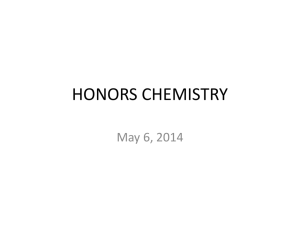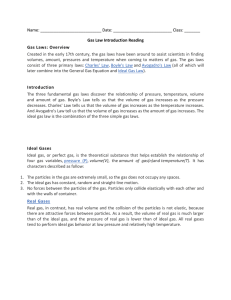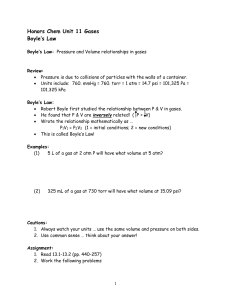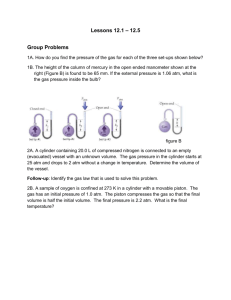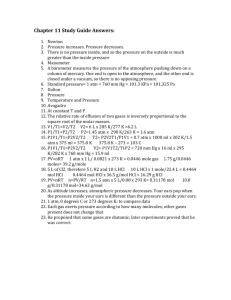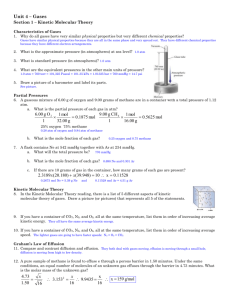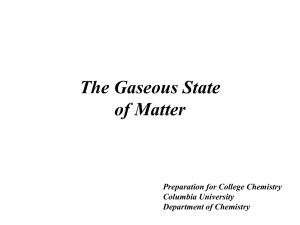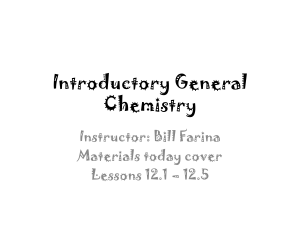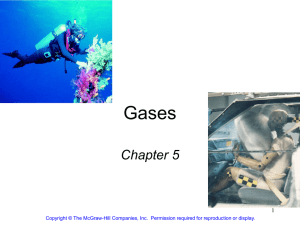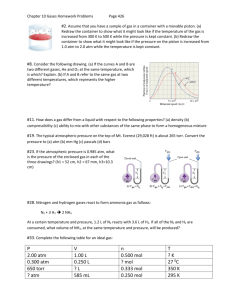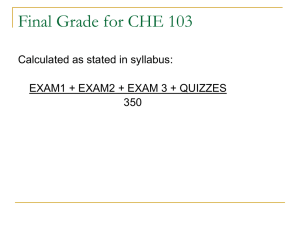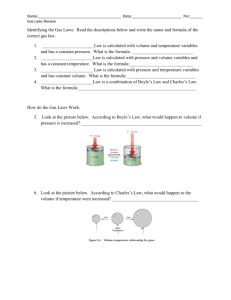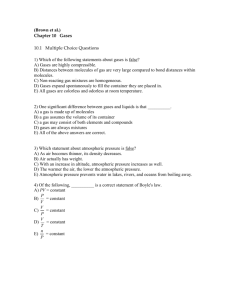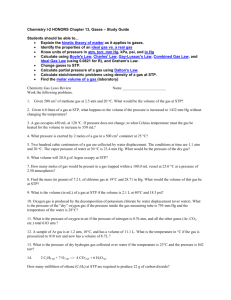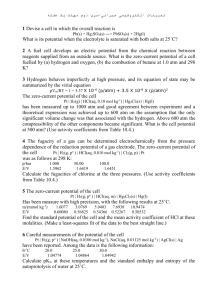Chapter 10: Gases
advertisement
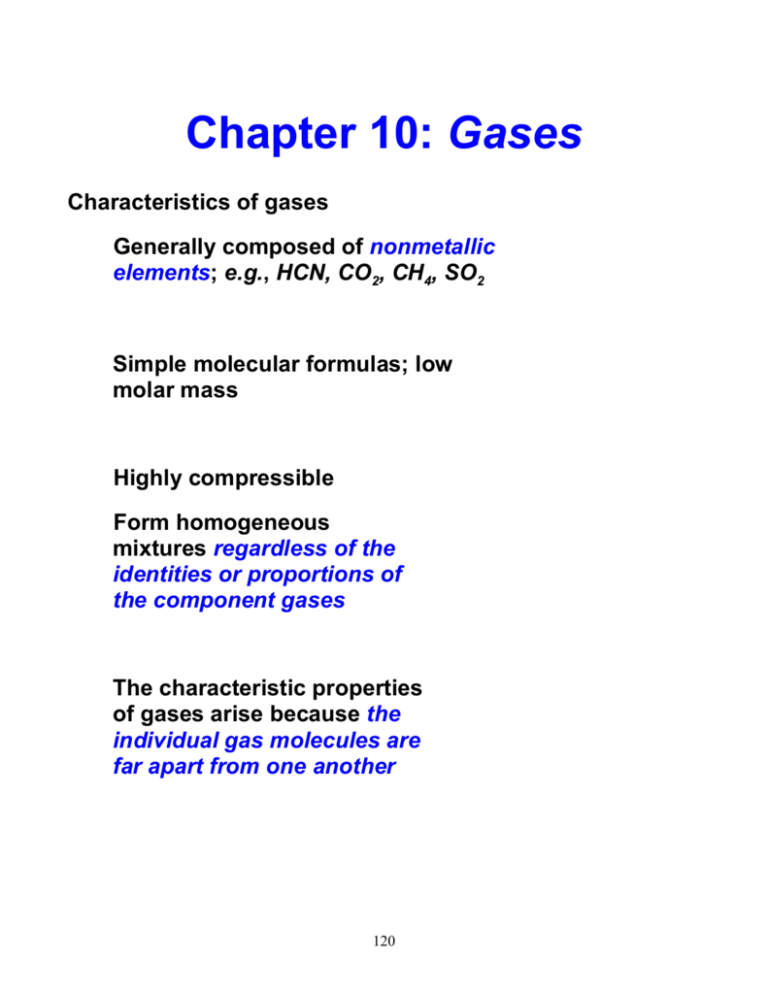
Chapter 10: Gases Characteristics of gases Generally composed of nonmetallic elements; e.g., HCN, CO2, CH4, SO2 Simple molecular formulas; low molar mass Highly compressible Form homogeneous mixtures regardless of the identities or proportions of the component gases The characteristic properties of gases arise because the individual gas molecules are far apart from one another 120 What measurable variables are required to define the state of a gas? We will consider P, V, T, and n Why choose these variables? Pressure F , or the force A F which acts on a given area, A Defined by P Units of pressure SI: 1 Pa = 1 N/m2 ( 1 N = 1 kg-m/s2) 1 atm = 1.01325 x 105 Pa non-SI: 1 torr = 1 mm Hg 1 atm = 760 mm Hg How do we measure pressure? 121 Hg barometer: used to measure atmospheric pressure Standard atmospheric pressure: pressure necessary to support a column of Hg 760 mm in height, typically at sea level hence, 1 atm = 760 mm Hg How to measure the pressure of an enclosed gas? (i.e., gas in a flask) manometer (open or closed-type) 122 Gas Laws We have chosen P, V, T, and n to describe the state of a gas How are these quantities related mathematically? Pressure-volume relationship: Boyle's Law Volume of a fixed quantity of a gas at constant temperature is inversely proportional to pressure i.e., P 1 (constant n, T) V Or P c (constant n and T) V Or PV=c (constant n,T) Boyle's law in graphical form: plot P vs V 123 Temperature-Volume relationship: Charles's Law Volume of a fixed quantity of a gas at constant pressure is directly proportional to absolute temperature V T (constant n, P) Or V = cT (constant n, P) graphically, 124 Quantity - Volume relationship: Avogadro's law Volume of a gas at constant temperature and pressure is directly proportional to n V n (constant T, P) or V cn (constant T, P) How can we combine Boyle's, Charles's, and Avogadro's laws to obtain a general relation between P, V, T, and n? The ideal gas law Recall Boyle: V 1/ P, constant n, T Charles: V T, constant n, P Avogadro: V n, constant P,T Combine these results: V ncT P 125 Let the proportionality constant = R; then, PV = nRT This is the ideal gas law Ideal gas: gas whose P,V,T behavior is described by the ideal gas law Note that R = gas constant Value & units of R depend on the units of P, V, n, T T always expressed in K quantity, n : moles P : usually atm V : usually in liters Numerical values of R: R 0.08206 R 8.314 liter atm mol K joule (SI units) mol K 126 What is the volume of 1.000 mol of an ideal gas at 273.15 K and 1.000 atm? 273.15 K (0o C) and 1.00 atm are referred to as standard temperature & pressure (STP) V for 1 mol of an ideal gas at STP is known as the molar volume of an ideal gas at STP Sample calculations E.g., At 37oC and 740 mm Hg, an ideal gas occupies a volume of 1.05 L. How many gas molecules are in the sample? 127 E.g., At what temperature would 0.270 mol of an ideal gas occupy a volume of 15.0 L at 2.54 atm? Now, consider a process carried out involving a fixed quantity of an ideal gas A fixed quantity of an ideal gas confined to a cylinder fitted with a movable piston is a nice way to think about this, e.g. Let the initial state of the n mol of gas be given by P1, T1, V1 128 Since n = constant, the ideal gas law gives PV nR = constant T 1 1 1 Now, move the piston up or down - take the system from P1, T1, V1 to P2, V2, T2 Since the quantity of gas is fixed, n does not change during the process, and PV P V T T 1 1 1 2 2 2 This is known as the combined gas law What happens to this relation: At constant P? At constant T? At constant V? 129 E.g., at 36oC and 1.00 atm, a gas occupies a volume of 0.600 L. How many liters will it occupy at 0oC and 0.205 atm? 130 Problems du Jour Assume that you have a cylinder with a movable piston. What would happen to the gas pressure inside the cylinder if you: (a) Decrease the volume to one-third the original volume at constant T (b) Reduce the Kelvin temperature to half the original value at constant V (c) Reduce the amount of gas to half while keeping the volume and temperature constant 131

